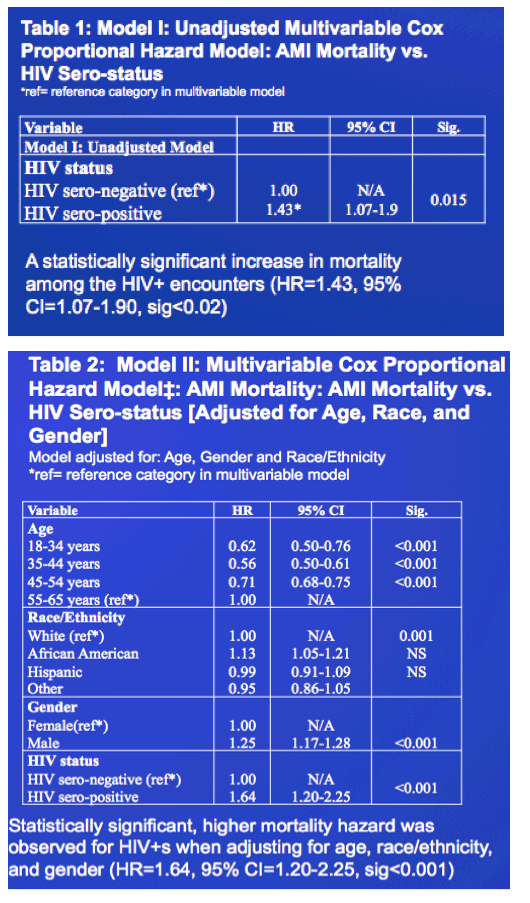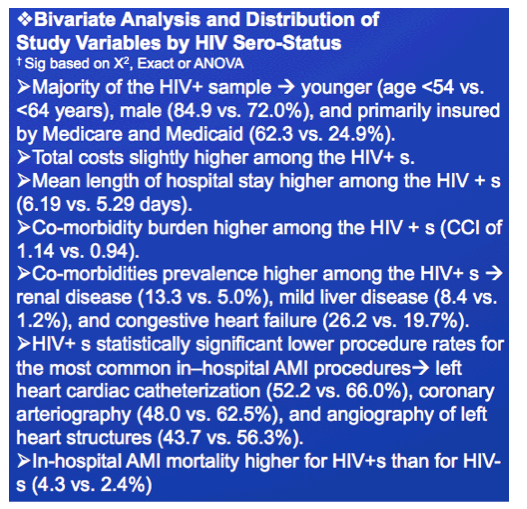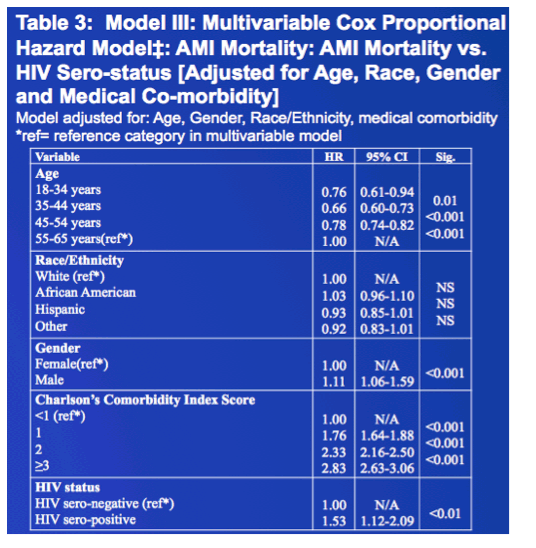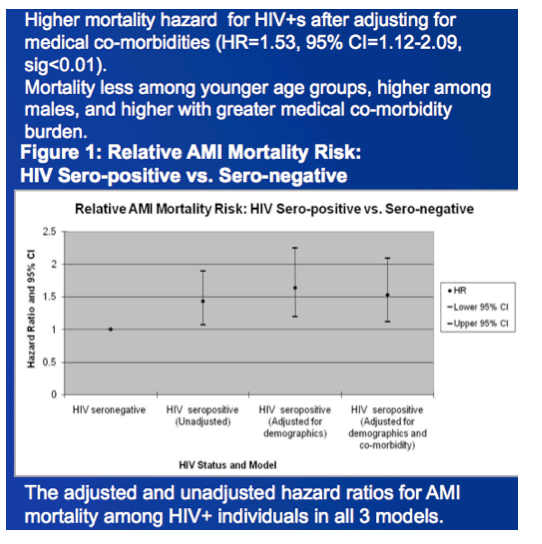 |
 |
 |
| |
In-Hospital Mortality from Acute Myocardial Infarction: HIV Seropositive vs. Seronegative Individuals
|
| |
| |
Reported by Jules Levin
52nd ICAAC, September 9-12, 2012, San Francisco
"The purpose of this study: To explore in-hospital AMI mortality risk among HIV+s vs. HIV-s....... Study results demonstrated unadjusted, statistically significant increased mortality hazard among HIV+s when compared to HIV-s admitted for an AMI (HR=1.43, 95% CI=1.07-1.90, sig<0.02)......Common associated procedures occurred at statistically significantly lower rates among HIV+s vs. HIV-s: left heart cardiac catheterization (52.2% vs. 66.0%), coronary arteriography (48.0% vs. 62.5%), and angiography of left heart structures (43.7% vs. 56.3%)...... Studies to evaluate factors associated with this differential outcome are required. Additionally, providers of care should be alert to the increased mortality burden when treating HIV+s with AMI...... Author Conclusion: Significant disparities for in-hospital AMI mortality among HIV+s when compared with HIV-s. Further studies are required to explore and describe pathophysiological, clinical, and health care process factors associated with differential AMI mortality."
Daniel Pearcea , Chizobam Anib, Yaminah Espinosa-Silvac , Ryan Clarkc ,
Khuteja Fatimad ,Munira Rahmanc Erik Dieboltc Bruce Ovbiagelee
a Department of Internal Medicine, College of Osteopathic Medicine of the Pacific, Western University of Health Sciences, Pomona, CA and Department of Internal Medicine, Arrowhead Regional Medical Center, Colton, CA, b Department of Family Medicine, Charles Drew University of Medicine and Science, Los Angeles cCollege of Osteopathic Medicine of the Pacific, Western University of Health Sciences, Pomona, CA, dCollege of Podiatric Medicine, Western University of Health Sciences, Pomona, CA e Department of Neurology, University of California, Los Angeles

Relative in-hospital mortality risk from an AMI event in HIV+ was 50% higher than in HIV- AMI encounters.
Co-morbidity burden CCI (26-28) higher among HIV+s vs. HIV-s [CCI - Charlston Co-morbidity Index asses the number & severity of co-morbid condition]
Except for congestive heart failure and renal disease, which were significantly higher in HIV+s, most of the common cardio-metabolic risk factors, such as hypertension, diabetes and cardiac arrhythmias, were lower in HIV+s
Greater risk of AMI in HIV+s may be due to direct pathological effects of HIV viremia on cardiac vasculature and function including, arterial endothelial inflammation, intimal fibrosis with luminal narrowing of coronary vessels, endothelial irritation, platelet dysfunction, activation of pro-inflammatory cytokines, thrombosis from reduced coronary blood flow, and ischemia.(18-20)
A higher prevalence of substance use (with deleterious cardiovascular effects) by HIV+s than HIV-s.(32)
Lower post AMI procedure rates for HIV+s than HIV-s receiving care during AMI encounters
While coronary artery bypass grafting (CABG) is safe in multi-vessel CAD in HIV+s(33), use of CABG was reported in less than half the HIV+s than in HIV-s.
Low socioeconomic status reported to lower relative AMI survival in the general population(39), and more HIV+s were on public insurance payer systems, adjustment for these factors did not significantly modify the mortality disparity.
Disparities in AMI for African American HIV+s vs. HIV- reflects relative HIV prevalence disparity observed in the US and did not significantly alter the mortality outcome disparities
Limitations include the use of administrative data that extrapolates AMI occurrence by using ICD-9 coding for incident disease encounters, over- or under-reporting AMI incidence. Observations of AMI incidence without documented procedures recorded may indicate false AMI diagnoses in the sample since it is rare that AMI encounters will exclude diagnostic or therapeutic risk assessment. This may also indicate secondary referral of patients to centers with more appropriate risk exploration and stratification capacity.
Conclusion: Significant disparities for in-hospital AMI mortality among HIV+s when compared with HIV-s.
Further studies are required to explore and describe pathophysiological, clinical, and health care process factors associated with differential AMI mortality.
ABSTRACT
Introduction:
Few studies have explored hospitalization outcome differences among individuals with HIV (HIV+) vs. HIV negative individuals (HIV-) with acute myocardial infarction (AMI).
Objective:
To explore in-hospital AMI mortality risk among HIV+s vs. HIV-s.
Methods:
Secondary data analysis of the Nationwide Inpatient sample database (1997-2006) including all AMI encounters with and without co-occurring HIV, identified using appropriate International Classification of Diseases codes (ICD). This sample approximates a stratified 20% sample of all non-Federal, short-term, general, and specialty hospitals serving adults in the United States. We conducted descriptive and survival analysis (Cox proportional hazard) for estimating mortality hazard differences among HIV+s when compared to HIV-s while adjusting for unique demographic and clinical co-morbidity factors.
Results:
Study results demonstrated unadjusted, statistically significant increased mortality hazard among HIV+s when compared to HIV-s admitted for an AMI (HR=1.43, 95% CI=1.07-1.90, sig<0.02).
Similar increased mortality hazard was also observed when adjusted for the influence of age, gender, ethnicity and medical co-morbidity (HR=1.53, 95% CI=1.12- 2.09, sig<0.01).
Common associated procedures occurred at statistically significantly lower rates among HIV+s vs. HIV-s: left heart cardiac catheterization (52.2% vs. 66.0%), coronary arteriography (48.0% vs. 62.5%), and angiography of left heart structures (43.7% vs. 56.3%).
Conclusion:
A significant additional mortality burden exists for HIV+s receiving in-hospital AMI care and significantly lower rates for the most common in-hospital AMI procedures occurred. Studies to evaluate factors associated with this differential outcome are required. Additionally, providers of care should be alert to the increased mortality burden when treating HIV+s with AMI.
INTRODUCTION
American Heart Association estimates 7.9 million individuals in US have had AMI with 935,000 new and recurrent cases annually(3,4).
There is decrease in mortality and morbidity due to AMI over the past two decades due to the medical advancements in HIV therapy, but increasing the risk of AMI with long term use (22-25).
An increase in arterial endothelial inflammation and intimal fibrosis with luminal narrowing comparatively in HIV positive youths autopsy(18).
HIV viremia is associated with coronary vessel endothelial irritation, platelet dysfunction, activation of pro-inflammatory cytokines, and thrombosis from reduced coronary blood flow and ischemia(18-21).
No study that we know has evaluated the relative additional burden associated with co-morbid HIV during an AMI hospitalization event.
OBJECTIVE
The purpose of this study was to explore in-hospital AMI mortality risk among HIV positive individuals when compared to HIV negative individuals
METHODS
Data:
Secondary data analysis of the Nationwide Inpatient sample database (1997-2006) including all AMI encounters with and without co-occurring HIV, identified using appropriate International Classification of Diseases codes (ICD).
The sampling strategy selects hospitals nationwide from State Inpatient Database according to defined strata based on ownership, bed size, teaching status, urban/rural location, and region.
HIV co-morbidity was identified using 042 and V08 ICD-9-CM codes.
Statistical Analysis:
In-hospital AMI mortality among HIV sero-positive vs. HIV sero-negative AMI encounters was examined. We used the Charlson Comorbidity Index (CCI) to assess the number and severity of co-morbid conditions.
Bivarient analysis. We conducted descriptive and survival analysis (Cox proportional hazard) for estimating mortality hazard differences among HIV+s when compared to HIV-s while adjusting for unique demographic and clinical co-morbidity factors. Statistical hypothesis were tested using the p<0.05 as the level of statistical significance.
The study was approved by the Arrowhead Regional Medical Center's Institutional Review Board.

Frequency and Distribution of All Study Variables (n= 1,428,146*)
Sample includes participants in the NIS dataset with; a) AMI encounter from 1997-2006, b) aged 18-65 years, c) greater than one (1) day hospital stay recorded for the encounter
Other race/ethnicity includes: Asian Pacific Islanders, Native Americans and Unspecified
Other primary payer includes; no pay, self pay, and unspecified
Majority of in-hospital encounters for AMI -> aged 55 years or older, white, male, and privately insured.
Majority of AMI encounters occurred in individuals with a CCI of 2 or less and the mean length of hospital stay was 5.29 days (SE=0.03).
Most common medical co-morbidities -> hypertension (51.0%), diabetes without complications (23.6%), congestive heart failure (19.7%), & chronic pulmonary disease (15.7%).
Most common in-hospital AMI-associated procedures: left heart cardiac catheterization (66.0%), coronary arteriography (62.5%), and angiography of left heart structures (56.2%).
There were 5,984 AMI encounters among individuals with co-occurring HIV. Overall AMI encounter mortality was 2.4% of all encounters.




REFERENCES
3. American Heart Association. Heart Disease and Stroke Statistics - 2009 Update. Dallas, Texas2009.
4. Peterson ED, Shah BR, Parsons L, Pollack CV, French WJ, Canto JG, et al. Trends in quality of care for patients with acute myocardial infarction in the National Registry of Myocardial Infarction from 1990 to 2006. American heart journal. 2008;156(6):1045-55.
18. Joshi VV P, B, Conner E, Sharer L, Oleske JM, Morrison S, Marin-Garcia J. Arteriopathy in children with acquired immune deficiency syndrome. Pediatr Pathol. 1987;7(3):261-75.
19. Paton P, Tabib A, Loire R, Tete R. Coronary artery lesions and human immunodeficiency virus infection. Res Virol. 1993 May-Jun;144(3):225-31.
20. Torre D, Pugliese A. Interleukin 18 and cardiovascular disease in HIV-1 infection: a partner in crime? AIDS Rev. 2010 Jan-Mar;12(1):31-9.
21. Triant VA, Lee H, Hadigan C, Grinspoon SK. Increased acute myocardial infarction rates and cardiovascular risk factors among patients with human immunodeficiency virus disease. J Clin Endocrinol Metab. 2007 Jul;92(7):2506-12.
22. Mary-Krause M, Cotte L, Simon A, Partisani M, Costagliola D. Increased risk of myocardial infarction with duration of protease inhibitor therapy in HIV-infected men. AIDS. 2003 Nov 21;17(17):2479-86.
23. Worm SW, Sabin C, Weber R, Reiss P, El-Sadr W, Dabis F, et al. Risk of myocardial infarction in patients with HIV infection exposed to specific individual antiretroviral drugs from the 3 major drug classes: the data collection on adverse events of anti-HIV drugs (D:A:D) study. J Infect Dis. 2010 Feb 1;201(3):318-30.
24. Friis-Moller N, Sabin CA, Weber R, d'Arminio Monforte A, El-Sadr WM, Reiss P, et al. Combination antiretroviral therapy and the risk of myocardial infarction. N Engl J Med. 2003 Nov 20;349(21):1993-2003.
25. Friis-Moller N, Reiss P, Sabin CA, Weber R, Monforte A, El-Sadr W, et al. Class of antiretroviral drugs and the risk of myocardial infarction. N Engl J Med. 2007 Apr 26;356(17):1723-35.
26. Charlson M, Szatrowski TP, Peterson J, Gold J. Validation of a combined comorbidity index. J Clin Epidemiol. 1994 Nov;47(11):1245-51.
27. Charlson ME, Pompei P, Ales KL, MacKenzie CR. A new method of classifying prognostic comorbidity in longitudinal studies: development and validation. J Chronic Dis. 1987;40(5):373-83.
28.Quan H, Sundararajan V, Halfon P, Fong A, Burnand B, Luthi JC, et al. Coding algorithms for defining comorbidities in ICD-9-CM and ICD-10 administrative data. Med Care. 2005 Nov;43(11):1130-9.
31. Zhou H, Pandak WM, Jr., Lyall V, Natarajan R, Hylemon PB. HIV protease inhibitors activate the unfolded protein response in macrophages: implication for atherosclerosis and cardiovascular disease. Mol Pharmacol. 2005 Sep;68(3):690-700.
32. Carey JW, Mejia R, Bingham T, Ciesielski C, Gelaude D, Herbst JH, et al. Drug use, high-risk sex behaviors, and increased risk for recent HIV infection among men who have sex with men in Chicago and Los Angeles. AIDS Behav. 2009 Dec;13(6):1084-96.
33.Boccara F, Cohen A, Di Angelantonio E, Meuleman C, Ederhy S, Dufaitre G, et al. Coronary artery bypass graft in HIV-infected patients: a multicenter case control study. Curr HIV Res. 2008 Jan;6(1):59-64.
39. McDavid Harrison K, Ling Q, Song R, Hall HI. County-level socioeconomic status and survival after HIV diagnosis, United States. Ann Epidemiol. 2008 Dec;18(12):919-27.
|
| |
|
 |
 |
|
|